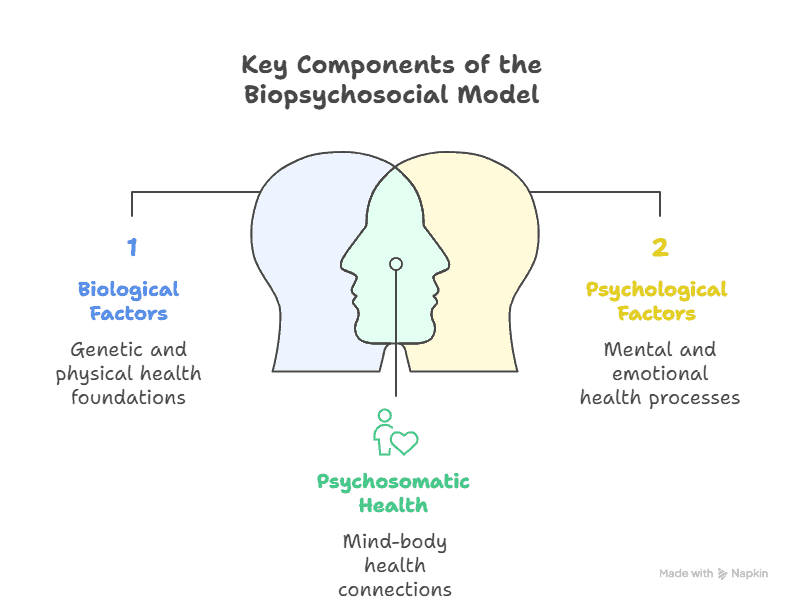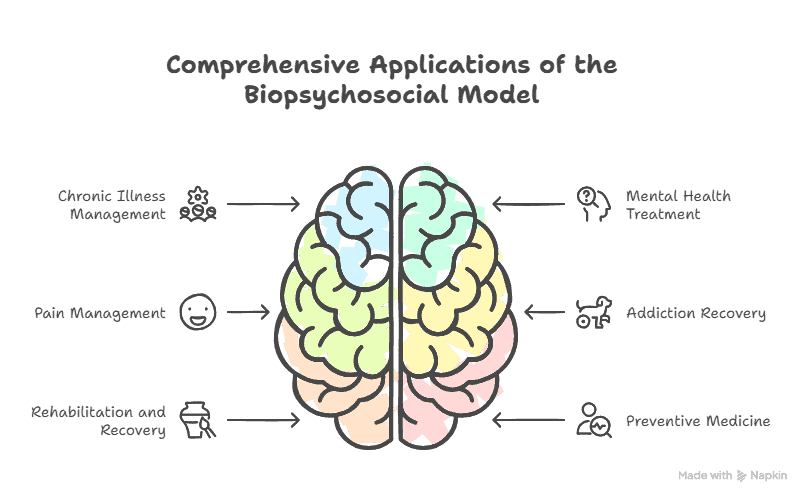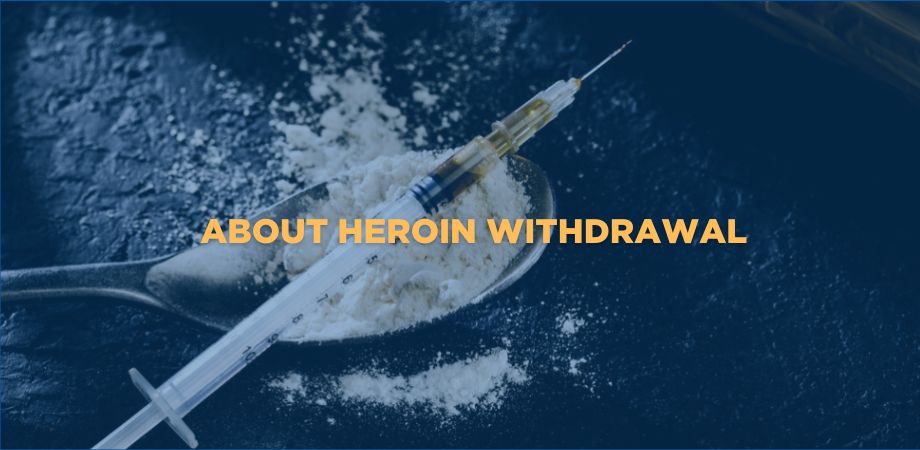Heroin withdrawal is a set of body reactions that happens when someone with heroin dependence or opioid use disorder (OUD) stops using heroin or uses much less. Doctors call this opioid withdrawal syndrome (OWS).
The main causes of heroin withdrawal are changes in brain chemicals and body tolerance. Heroin affects mu-opioid receptors and endorphins (the brain’s natural pain relief chemical) and dopamine (the brain’s reward chemical). When heroin use stops, the central nervous system (CNS) becomes overactive, causing withdrawal symptoms.
The common symptoms of heroin withdrawal include severe craving and flu-like illness, shaking, sweating, nausea, muscle pain, anxiety, sleep problems, depression, and stomach problems.
The timeline of heroin withdrawal begins 6-12 hours after the last use, peaks at 24-72 hours with anxiety, nausea, and muscle pain, then slowly improves over 5-10 days, though cravings may persist longer.
The diagnosis of heroin withdrawal involves heroin detox, which includes medical checks, doctors’ questioning about drug use history, and tests such as the clinical opiate withdrawal scale (COWS).
The treatment of heroin withdrawal includes medical detox, inpatient treatment, outpatient treatment, medications like methadone, buprenorphine, clonidine, and lofexidine, plus support groups like Narcotics Anonymous (NA), counselling, and therapy.
The risk factors of untreated heroin withdrawal include complications like dehydration, relapse, overdose after relapse, and mental health issues.
The prevention strategies for heroin withdrawal include medical help, gradual dose reduction, staying hydrated, support groups, and avoiding triggers.
What is Heroin Withdrawal?
Heroin withdrawal is the body and brain reacting when someone stops or reduces heroin use after using it regularly. It happens because of physical dependence, where the body needs heroin to work normally, and psychological dependence, where the mind strongly wants it to handle feelings.
Heroin changes brain chemicals like endorphins (the brain’s natural pain relief chemical) and dopamine (the brain’s reward chemical). When heroin use stops, the brain cannot make enough ‘feel-good’ chemicals, causing pain and discomfort. Doctors call this opioid withdrawal syndrome. In severe cases, called acute withdrawal, heroin withdrawal symptoms are life-threatening and need immediate care.
What is the Difference Between Heroin Withdrawal and Heroin Detox?

The main difference between heroin withdrawal and heroin detox is that withdrawal is the body’s natural response to stopping heroin use. In contrast, heroin detox is the medical process that safely manages the body’s natural reactions.
Heroin withdrawal occurs immediately after someone stops using heroin, causing painful symptoms such as shaking, sweating, and intense cravings. If left unmanaged, heroin withdrawal symptoms are frightening and potentially life-threatening. Therefore, opioid detox is necessary.
Heroin detox involves medical supervision by doctors and nurses, who provide medication, fluids, and continuous care to prevent serious complications during withdrawal.
The table below shows the main difference between heroin withdrawal and heroin detox in medical care.
|
Heroin Withdrawal |
Heroin Detox |
|
The body and brain reactions to stopping heroin |
Medical process to safely manage heroin withdrawal |
|
It happens when heroin use stops |
It needs trained doctors and nurses for medical care |
|
Dangerous without supervised management |
Safe with doctors’ help, family support, and support groups |
|
Has painful symptoms like shaking and throwing up |
Use medication like buprenorphine to alleviate symptoms, including shaking and flu-like symptoms, and make them feel better. |
|
Last 6 hours -10 days of feeling very sick |
Give comfort and improve withdrawal after 10 days |
|
Causes serious problems like seizures, a fast heartbeat, and dehydration |
Stops dangerous issues like seizures and dehydration by watching heart rate and giving fluids |
What are the Causes of Heroin Withdrawal?
The main causes of heroin withdrawal are:
- Body Tolerance
- Brain Chemical Imbalance
The main causes of heroin withdrawal are explained below.
- Body Tolerance: Body Tolerance is when the body gets used to heroin, so over time, the body wants more of it to feel the same effects. The liver, kidneys, and stomach adjust to heroin in the blood, and without it, one experiences nausea, pain, and weakness. The heart and lungs are also affected. Heroin changes the nerve that controls breathing and heartbeat. When the heroin is withdrawn, the nerves overreact, leading to sweating, shaking, and cramps. Over time, the brain and body get stuck in a cycle where heroin use increases cravings, and stopping brings painful withdrawal.
- Brain Chemical Imbalance: A Brain chemical imbalance means the brain does not make the right amount of its natural chemicals. Heroin changes the brain’s natural ‘feel-good’ chemicals, that is, endorphins (help the body handle pain) and dopamine (control pleasure and reward). When one uses heroin, the drug takes over, and the brain makes less of these chemicals. When heroin use stops, the brain does not have enough of these chemicals. This chemical imbalance causes muscle pain, depression, and sadness.
What Are the Symptoms of Heroin Withdrawal?
The symptoms of heroin withdrawal are muscle pain, shaking, flu-like illness (like a runny nose), nausea, anxiety, depression, trouble sleeping, stomach problems (like loose stools), fast heartbeat, difficulty breathing, high blood pressure, intense cravings, hallucinations, and panic attacks.
These heroin withdrawal symptoms are put into physical and physiological categories, ranging from mild to moderate to severe. The opioid withdrawal symptoms happen when someone with heroin dependence stops using heroin, and the central nervous system (CNS) becomes too active without heroin’s calming effect.
Physical Symptoms of Heroin Withdrawal
The physical heroin withdrawal symptoms are:
- Muscle pain
- Shaking
- Sweating
- Flu-like illness (e.g., runny nose)
- Nausea
- Stomach problems (e.g., loose stools and cramps)
- Fast heartbeat
- High blood pressure
Psychological Symptoms of Heroin Withdrawal
The Psychological heroin withdrawal symptoms are:
- Trouble sleeping
- Depression
- Anxiety
- Mood changes
- Loss of appetite
- Strong cravings
- Hallucinations
- Confusion
- Memory problems
- Panic attacks
The physical and psychological symptoms of heroin withdrawal are divided into mild, moderate, and severe depending on how serious they get during heroin detox.
Mild Heroin Withdrawal Symptoms
The mild heroin withdrawal symptoms start 6 to 13 hours after the last heroin use. The mild heroin withdrawal symptoms are:
- Runny nose
- Watery eyes
- Sweating
- Muscle pain
- Trouble sleeping
- Anxiety
- Loss of appetite
The mild symptoms of heroin withdrawal are explained below.
- A runny nose occurs when the nose produces excessive mucus and continues to drip.
- Watery eyes are eyes that produce excessive tears and feel constantly wet.
- Sweating becomes too heavy even when it’s not hot outside.
- Muscle pain is the experience of sore muscles all over the body, like after strenuous exercise.
- Trouble sleeping is having a hard time falling asleep through the night.
- Anxiety is feeling worried, scared, or restless because brain chemicals aren’t working properly.
Moderate Heroin Withdrawal Symptoms
The moderate heroin withdrawal symptoms occur 24 to 72 hours ( 1 to 3 days) after the last heroin use, and intensify beyond mild symptoms.
The moderate heroin withdrawal symptoms are:
- Nausea
- Diarrhea
- Stomach cramps
- Chills
- Goosebumps
- Dilated pupils
- Increased heart rate
- Restlessness
- Irritability
- Strong cravings
The moderate heroin withdrawal symptoms are explained below.
- Nausea is the feeling of throwing up due to gastrointestinal distress during heroin detox.
- Diarrhoea is characterised by frequent, loose, and watery bowel movements resulting from the digestive system’s hyperactivity.
- Stomach cramps are painful muscle contractions in the abdominal area that cause sharp, intense discomfort.
- Chills are sudden feelings of cold accompanied by shivering, even in warm temperatures.
- Goosebumps appear as raised hair follicles on the skin.
- Dilated pupils are enlarged pupils that remain wide even in bright light, indicating nervous system hyperactivity.
- An increased heart rate is the heart beating faster than usual, often exceeding 100 beats per minute.
- Restlessness is characterised by an inability to stay still or remain calm, often accompanied by constant fidgeting or excessive movement.
- Irritability involves intense emotional reactions, a quick temper, and low frustration tolerance, caused by a chemical imbalance of endorphins and dopamine.
- Strong cravings are intense psychological urges to use heroin.
Severe Heroin Withdrawal Symptoms
The severe heroin withdrawal symptoms peak 3 to 5 days after the last heroin use and are the most intense heroin withdrawal symptoms.
The severe heroin withdrawal symptoms are:
- Hallucinations
- Severe depression
- Panic attacks
- Extreme agitation
- Severe dehydration
- Intense muscle spasms
- Tachycardia
The severe heroin withdrawal symptoms are explained below.
- Hallucinations are the perception of seeing, hearing, or feeling things that are not present.
- Severe depression is a persistent feeling of hopelessness and dizziness.
- Panic attacks are sudden episodes of intense fear accompanied by symptoms like chest pain, shortness of breath, and dizziness.
- Extreme agitation is violent restlessness, aggression, and inability to control emotions or physical responses.
- Severe dehydration occurs when excessive fluid loss occurs through vomiting, diarrhoea, and sweating.
- Intense muscle spasms are uncontrollable muscle contractions that cause significant pain throughout the body.
- Tachycardia is an abnormally fast heartbeat, typically exceeding 100 beats per minute, which causes chest pain, dizziness, or shortness of breath.
What Are the Early Signs of Heroin Withdrawal?
The early signs of heroin withdrawal start 6 to 12 hours after the last heroin use.
The early signs of heroin withdrawal are:
- Restlessness
- Anxiety
- Runny nose
- Watery eyes
- Muscle aches
- Sleep disturbance
- Loss of appetite
- Mild agitation
- Initial cravings
What is Tachycardia?
Tachycardia occurs when your heart beats too fast during heroin use or withdrawal. Heroin affects your heart by slowing it down. When heroin starts wearing off or when you stop using, your heart begins beating much faster than normal, exceeding 100 beats per minute even when you’re at rest. Your heart has to work harder to pump blood, and you’ll feel it pounding in your chest, experience dizziness, or have trouble breathing.
Tachycardia caused by heroin withdrawal is dangerous because it puts extra stress on your heart. That’s why doctors need to monitor you and may give medications like methadone to slow your heart rate to a safer rate.
How Long Does Heroin Withdrawal Last?
Heroin withdrawal lasts for 7 to 10 days for acute physical symptoms, with psychological symptoms persisting for weeks or months.
Heroin withdrawal timeline begins 6 to 12 hours after the last heroin use and reaches peak intensity within 24 to 72 hours. Physical heroin withdrawal symptoms like nausea, vomiting, and muscle aches resolve within one week. Psychological heroin withdrawal symptoms like depression, anxiety, and intense cravings continue during post-acute withdrawal syndrome.
Here’s a timeline of heroin withdrawal showing how symptoms change over time.
- Early Withdrawal Stage: It happens 6 to 12 hours after the last heroin use, marking the initial response to heroin absence in the body. Early symptoms include restlessness, anxiety, a runny nose, and sleep troubles.
- Peak Withdrawal Stage: It occurs 12 to 72 hours after heroin cessation. Peak heroin withdrawal symptoms include severe nausea, diarrhoea, intense muscle pain, and overwhelming cravings.
- Late withdrawal Stage: Spans 4 to 7 days after heroin use—symptoms like nausea, vomiting, and diarrhoea decrease in intensity. Sleep patterns start to improve, as muscle aches and pain become more manageable.
- Post-Acute Withdrawal Stage: it begins one week of heroin cessation and continues for weeks to months. Symptoms include persistent depression, anxiety episodes, sleep disturbances, and fatigue.
The table below shows a complete heroin withdrawal timeline and its symptoms at each stage.
|
Stage |
Timeline |
Primary Symptoms |
|
Early Withdrawal |
6-12 hours after the last heroin dose |
Anxiety, muscle aches, flu-like illness, restlessness |
|
Peak Withdrawal |
24-72 hours after the previous dose |
Severe nausea, vomiting, diarrhoea, intense cravings, depression |
|
Late Withdrawal |
4-7 days after the last heroin dose |
Decreasing physical symptoms, continued fatigue, and mood changes |
|
Post-Acute Withdrawal |
1 week+ |
Depression, anxiety, sleep disturbances, intermittent cravings |
How Do Doctors Diagnose Heroin Withdrawal?
Doctors diagnose heroin withdrawal by checking your medical history, doing a physical exam, and using special tests such as the Clinical Opiate Withdrawal Scale (COWS) test. Healthcare providers must be careful, because according to the National Institute on Drug Use, heroin withdrawal symptoms like stomach pain, shaking, sweating, and flu-like illness happen with many different conditions, and sometimes lead to misdiagnosis.
Here are the tools and steps doctors use to identify and diagnose heroin withdrawal.
- Medical history check
- Physical history check
- The Clinical Opiate Withdrawal Scale (COWS) test
- Lab tests
- DSM-5 Rules
The doctor’s steps and tools for diagnosing heroin withdrawal are explained below.
- Medical History Check: A medical history check is when doctors ask questions about a patient’s use of drugs. They want to know when was the last time you used heroin, how long you have used it, how much you have used each day, and what other medicines or drugs you take. These medical history questions help doctors understand when withdrawal started and how bad it is possible to get.
- Physical Body Exam: A physical body exam is conducted by doctors to assess physical indicators for heroin withdrawal, including measuring heart rate, body temperature, pupil size, muscle stiffness, listening to the stomach, and signs of sweating or shaking.
- The COWS test: The Clinical Opiate Withdrawal Scale is a specialised checklist that measures 11 withdrawal signs, including restlessness, large pupils, muscle aches, runny nose, goose bumps, shaking, vomiting, worry, and muscle twitches. Doctors assign a numerical score to each symptom to assess the severity of the withdrawal.
- Lab tests: Lab tests are urine and blood tests that show the amount of heroin in the blood.
- DSM-5 Rules is an official medical book that outlines the rules for confirming withdrawal. It tells the doctor exactly what symptoms must be present and how long they must last to say someone has heroin withdrawal.
What Are the Treatment Options for Heroin Withdrawal?
The common treatment options for heroin withdrawal include medical detox, medications like methadone and buprenorphine, outpatient treatment programs, inpatient treatment programs, therapy, support groups like Narcotics Anonymous (NA), and medication-assisted treatment (MAT).
According to the UNODC World Drug Report 2024, despite an estimated 64 million people worldwide suffering from drug use disorders, only one in 11 receives treatment. However, when it comes to opioid use disorder (OUD), it’s necessary to seek medical help to assist with heroin withdrawal symptoms.
The treatment options for heroin withdrawal are explained below.
Medical Detox
Medical detox is when doctors or nurses watch over you 24/7, giving you medicines to make you feel less sick and safe as your body gets used to not having heroin.
Medications
Medications are special drugs doctors give you to feel better during withdrawal and stop craving heroin so much. Doctors give methadone and buprenorphine, which work like heroin but are safer, and clonidine and lofexidine to stop shaking, sweating, and a fast heartbeat.
Outpatient Treatment Program
The outpatient treatment program is a program where you visit the hospital to receive medicine, speak with counsellors, and consult with doctors, and then return home.
Inpatient Treatment Program
An inpatient treatment program is a program where you live at the treatment facility, such as a hospital, where doctors monitor you 24/7, administer medications, provide meals, and offer assistance from hospital staff when needed until you recover.
Therapy
Therapy is talking to a counsellor about feelings and thoughts that make you want to use heroin. The counsellor teaches you new ways to feel better when sad or stressed without using heroin.
Support Groups
Support groups are meetings like Narcotics Anonymous (NA) for people who used to take heroin, where they share and help each other stay calm.
Medication-Assisted Treatment (MAT
Medication-Assisted Treatment (MAT) is an evidence-based approach that combines medications with counselling, behavioural therapy, and peer support for treating heroin use disorder.

What Are the Risks of Untreated Heroin Withdrawal?
The common risks of untreated heroin withdrawal are listed below.
- Severe dehydration occurs when the body loses too much water due to vomiting and frequent diarrhea.
- Electrolyte imbalance occurs when the body loses essential minerals, such as sodium and potassium, that are crucial for the proper functioning of muscles, organs, and the heart. Electrolyte imbalances develop in the setting of vomiting and diarrhoea.
- Extreme discomfort means feeling terrible pain and sickness that makes life unbearable. Heroin withdrawal causes emotional and physical discomfort. If not treated, you feel horrible muscle pain, sleeplessness, shake uncontrollably, and feel like you have the worst flu ever.
- Relapse is going back to using heroin after trying to quit. When withdrawal symptoms feel too horrible to handle, one uses heroin again to make the pain stop.
- An overdose is taking too much heroin at a time, which stops breathing and cause death. According to the Centers for Disease Control and Prevention (CDC), approximately 5% of all opioid overdose deaths in 2023 involved heroin. AFTER withdrawal, the body can’t handle the same amount of heroin as before. If one uses heroin again, it’s easy to take too much and die.
- Mental health problems include bad feelings like sadness, fear, and thoughts of hurting oneself. Without proper medical care, heroin withdrawal causes severe depression, anxiety, and suicidal thoughts.
How to Prevent Heroin Withdrawal?
To prevent heroin withdrawal, consider working with doctors and getting medical help instead of trying to quit alone. Supervised management for heroin withdrawal prevents dangerous withdrawal symptoms such as relapse and overdose, keeping you safe.
Here are safe ways doctors use to prevent heroin withdrawal.
- Medication-Assisted Treatment (MAT): MAT is a combination of using safe medicine such as methadone, counselling, therapy, and support groups like Narcotics Anonymous to help with heroin withdrawal.
- Medical supervision: Medical supervision is having doctors and nurses watch over someone while they quit heroin. They check heart rate, blood pressure, and other vital body functions daily, ensuring that nothing dangerous occurs during the quitting process.
- Gradual tapering: Gradual tapering is using less heroin or replacement safe medicine each week instead of stopping heroin all at once.
- Support groups: Support groups include family members, talking to therapists, going to counselling sessions, and joining groups like Narcotics Anonymous to help with heroin withdrawal.
- Relapse prevention: Relapse prevention is learning how to stay away from heroin after quitting by avoiding places, people, and things that make someone want to use drugs again.
What is the Difference Between Heroin Dependence and Heroin Addiction?
The difference between heroin dependence and heroin addiction is that heroin dependence means the body needs heroin to feel normal. In contrast, heroin addiction includes both physical and mental obsession with heroin use.
Heroin dependence happens when the body gets used to having heroin every day and feels sick without it. Heroin addiction is when the brain changes and makes one want heroin so badly that the brain can’t say no, even when it ruins their life, health, and family.
The signs and symptoms of heroin dependence include;
- Craving heroin and constantly thinking of the next time to use it.
- Spending all money on heroin instead of bills or food, lying to family about heroin use, avoiding friends who don’t use drugs, and getting in trouble at work or school because heroin is more important than responsibilities.
- Planning the whole day around getting and using heroin, and continuing to use it when it causes family or health problems.
- Signs include shaking hands, sweating, and flu-like illness when heroin wears off.
What is the difference between Heroin Withdrawal and Heroin Overdose?
The difference between heroin withdrawal and heroin overdose is that withdrawal happens when someone stops using heroin, and makes them feel like they have the worst flu-like illness. They experience withdrawal symptoms like throwing up, diarrhoea, shaking, sweating, and muscle pain.
In contrast, heroin overdose happens when someone uses too much heroin at a go and the body can’t handle it, which makes someone fall asleep so deeply, their breathing slows or stops entirely, and causes death in just a few minutes.
Heroin withdrawal makes someone feel terrible, but rarely kills them.





